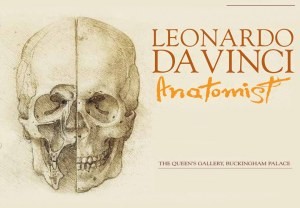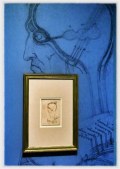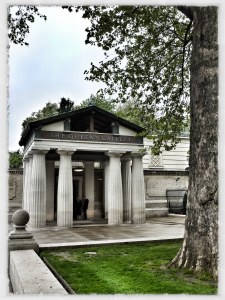 A 5:30 am start is not the usual modus operandi of this freelance journalist but with an invitation to a Bloggers’ Breakfast at Buckingham Palace in London to see the launch of the Leonardo da Vinci exhibition at the BH Gallery scheduled for 8:30 am an early train from the outskirts of Cambridge was needed.
A 5:30 am start is not the usual modus operandi of this freelance journalist but with an invitation to a Bloggers’ Breakfast at Buckingham Palace in London to see the launch of the Leonardo da Vinci exhibition at the BH Gallery scheduled for 8:30 am an early train from the outskirts of Cambridge was needed.
Leonardo da Vinci is, to some, nothing more than a great artist, but to us scientists, he was a pioneering polymath. His ground-breaking studies of the human body, which are now on display in the largest-ever exhibition of his anatomical work, were centuries ahead of their time. The exhibition launches almost 500 years after Leonardo’s death and features 87 pages from his notebooks, including 24 sides of previously unexhibited material.
After Leonardo’s death in 1519, many of his drawings remained unpublished and were effectively lost to the world until the 20th century. Meanwhile, Flemish anatomist Andreas Vesalius published his treatise, De humani corporis fabrica (On the fabric of the human body) in 1543. This tome would become the most important work on anatomy ever published and to this day anatomical history is divided into pre- and post-Vesalian periods.
 Leonardo’s drawings are quite astounding as is the fact that all of his writing is a mirror image of what you would expect. This was not, however, meant to deceive or hide information. Indeed, at the time the dissection of human bodies was perfectly well accepted by the Church and the law. This was the renaissance after all, and Leonardo very much wanted the knowledge he acquired and his lifeworks to be published. Gallery curator Martin Clayton told me that the true reason was nothing less mundane than that Leonardo didn’t want to smudge his ink because he wrote left-handed, something not uncommon among those who could write 500 years ago.
Leonardo’s drawings are quite astounding as is the fact that all of his writing is a mirror image of what you would expect. This was not, however, meant to deceive or hide information. Indeed, at the time the dissection of human bodies was perfectly well accepted by the Church and the law. This was the renaissance after all, and Leonardo very much wanted the knowledge he acquired and his lifeworks to be published. Gallery curator Martin Clayton told me that the true reason was nothing less mundane than that Leonardo didn’t want to smudge his ink because he wrote left-handed, something not uncommon among those who could write 500 years ago.
 Leonardo’s dissection of human tissues (usually male cadavers of executed criminals) and those of animals are quite astounding in their accuracy and his famous dissection of a human skull displays, to the modern anatomist’s eye, an insight into what cuts would best reveal the inner details perfectly. The understanding of many physiological processes, such as breathing (the lungs, Leonardo though, simply cooled the heart), the brain had three chambers, the purpose and flow of blood (arteries carried blood from the heart, the liver made blood and secreted it into the veins) were, to put it kindly, totally wrong.
Leonardo’s dissection of human tissues (usually male cadavers of executed criminals) and those of animals are quite astounding in their accuracy and his famous dissection of a human skull displays, to the modern anatomist’s eye, an insight into what cuts would best reveal the inner details perfectly. The understanding of many physiological processes, such as breathing (the lungs, Leonardo though, simply cooled the heart), the brain had three chambers, the purpose and flow of blood (arteries carried blood from the heart, the liver made blood and secreted it into the veins) were, to put it kindly, totally wrong.
There was also the question of sex and how the spirit or soul fitted into the process of conception. In his earlier work, Leonardo showed the penis having two tubes one of which carried the material part of the male seed, the other carried the “animal spirit” down from the spine and into the woman. This was obviously an attempt to explain the duality of the human condition – mind and matter – and to reconcile the newly emerging science with the fictions of creationism. Leonardo correctly abandoned the two-pipe system in later work.
As to pregnancy itself, given that female cadavers were less readily available than those of deceased male criminals, Leonardo’s work on the anatomy of a pregnant female was informed by his work on the dissection of a cow. His drawings show the multiple placentas, the ovaries placed beneath the uterus and the enormous suspensory ligaments within the female, all of which are perfect for bearing a growing calf, but are simply not present in women.
 One image that is missing from the collection is, of course, the Vitruvian Man, perhaps one of the most iconic and famous works of art. The Vitruvian Man was drawn after Roman architect Marcus Vitruvius Pollio. He had suggested that somehow the perfect man could, with arms and legs akimbo, transect a perfect circle and a perfect square. In his work, Leonardo measured lengths, ratios, and angles but could not find those perfect ratios suggested 1500 years before. Instead, Leonardo obtained odd fractions 5/11’s, 7/17th’s none of which seemed to point to the perfect circle or the perfect man and he turned back from what is essentially a research dead-end. If you want to see Leonardo’s Vitruvian Man in the flesh, as it were, it is housed at the Gallerie dell’Accademia in Venice, Italy, but only occasionally displayed.
One image that is missing from the collection is, of course, the Vitruvian Man, perhaps one of the most iconic and famous works of art. The Vitruvian Man was drawn after Roman architect Marcus Vitruvius Pollio. He had suggested that somehow the perfect man could, with arms and legs akimbo, transect a perfect circle and a perfect square. In his work, Leonardo measured lengths, ratios, and angles but could not find those perfect ratios suggested 1500 years before. Instead, Leonardo obtained odd fractions 5/11’s, 7/17th’s none of which seemed to point to the perfect circle or the perfect man and he turned back from what is essentially a research dead-end. If you want to see Leonardo’s Vitruvian Man in the flesh, as it were, it is housed at the Gallerie dell’Accademia in Venice, Italy, but only occasionally displayed.
Despite Leonardo’s various misconceptions and his Vitruvian U-turn, his dissections and drawings are nevertheless highly precise, incredibly detailed, and literally centuries ahead of their time. The exhibition Leonardo da Vinci: Anatomist brings his cadavers to life at The Queen’s Gallery, Buckingham Palace, until 7th October 2012.
An astounding iPad app is also available for download from the iTunes store. The app not only allows you to zoom in on very high-resolution scans of the different works but has accompanying text as well as a reverse  magnifier for Leonardo’s writing. Poke his text and an English translation appears too. Very much worth the price especially as it includes all 268 human and animal anatomical drawings by Leonardo in the collection. The app includes video commentary and modern, interactive anatomical models.
magnifier for Leonardo’s writing. Poke his text and an English translation appears too. Very much worth the price especially as it includes all 268 human and animal anatomical drawings by Leonardo in the collection. The app includes video commentary and modern, interactive anatomical models.
With thanks to Rachel Woollen of the Royal Collection for the invitation to a fascinating exhibition.
 So, as I was saying, I was at Buck House earlier this week. I know, you’re thinking the knighthood is well overdue, but I’m afraid I was only there for breakfast, not with Liz and Phil, but with Rachel Woollen, Martin Clayton and others from the Royal Collection and fellow blogging types, including
So, as I was saying, I was at Buck House earlier this week. I know, you’re thinking the knighthood is well overdue, but I’m afraid I was only there for breakfast, not with Liz and Phil, but with Rachel Woollen, Martin Clayton and others from the Royal Collection and fellow blogging types, including  Up to Green Park tube and a quick link to Leicester Square to meet up with the mighty
Up to Green Park tube and a quick link to Leicester Square to meet up with the mighty  A 5:30 am start is not the usual modus operandi of this freelance journalist but with an invitation to a Bloggers’ Breakfast at Buckingham Palace in London to see the launch of the Leonardo da Vinci exhibition at the BH Gallery scheduled for 8:30 am an early train from the outskirts of Cambridge was needed.
A 5:30 am start is not the usual modus operandi of this freelance journalist but with an invitation to a Bloggers’ Breakfast at Buckingham Palace in London to see the launch of the Leonardo da Vinci exhibition at the BH Gallery scheduled for 8:30 am an early train from the outskirts of Cambridge was needed. Leonardo’s drawings are quite astounding as is the fact that all of his writing is a mirror image of what you would expect. This was not, however, meant to deceive or hide information. Indeed, at the time the dissection of human bodies was perfectly well accepted by the Church and the law. This was the renaissance after all, and Leonardo very much wanted the knowledge he acquired and his lifeworks to be published. Gallery curator Martin Clayton told me that the true reason was nothing less mundane than that Leonardo didn’t want to smudge his ink because he wrote left-handed, something not uncommon among those who could write 500 years ago.
Leonardo’s drawings are quite astounding as is the fact that all of his writing is a mirror image of what you would expect. This was not, however, meant to deceive or hide information. Indeed, at the time the dissection of human bodies was perfectly well accepted by the Church and the law. This was the renaissance after all, and Leonardo very much wanted the knowledge he acquired and his lifeworks to be published. Gallery curator Martin Clayton told me that the true reason was nothing less mundane than that Leonardo didn’t want to smudge his ink because he wrote left-handed, something not uncommon among those who could write 500 years ago. Leonardo’s dissection of human tissues (usually male cadavers of executed criminals) and those of animals are quite astounding in their accuracy and his famous dissection of a human skull displays, to the modern anatomist’s eye, an insight into what cuts would best reveal the inner details perfectly. The understanding of many physiological processes, such as breathing (the lungs, Leonardo though, simply cooled the heart), the brain had three chambers, the purpose and flow of blood (arteries carried blood from the heart, the liver made blood and secreted it into the veins) were, to put it kindly, totally wrong.
Leonardo’s dissection of human tissues (usually male cadavers of executed criminals) and those of animals are quite astounding in their accuracy and his famous dissection of a human skull displays, to the modern anatomist’s eye, an insight into what cuts would best reveal the inner details perfectly. The understanding of many physiological processes, such as breathing (the lungs, Leonardo though, simply cooled the heart), the brain had three chambers, the purpose and flow of blood (arteries carried blood from the heart, the liver made blood and secreted it into the veins) were, to put it kindly, totally wrong. One image that is missing from the collection is, of course, the Vitruvian Man, perhaps one of the most iconic and famous works of art. The Vitruvian Man was drawn after Roman architect Marcus Vitruvius Pollio. He had suggested that somehow the perfect man could, with arms and legs akimbo, transect a perfect circle and a perfect square. In his work, Leonardo measured lengths, ratios, and angles but could not find those perfect ratios suggested 1500 years before. Instead, Leonardo obtained odd fractions 5/11’s, 7/17th’s none of which seemed to point to the perfect circle or the perfect man and he turned back from what is essentially a research dead-end. If you want to see Leonardo’s Vitruvian Man in the flesh, as it were, it is housed at the Gallerie dell’Accademia in Venice, Italy, but only occasionally displayed.
One image that is missing from the collection is, of course, the Vitruvian Man, perhaps one of the most iconic and famous works of art. The Vitruvian Man was drawn after Roman architect Marcus Vitruvius Pollio. He had suggested that somehow the perfect man could, with arms and legs akimbo, transect a perfect circle and a perfect square. In his work, Leonardo measured lengths, ratios, and angles but could not find those perfect ratios suggested 1500 years before. Instead, Leonardo obtained odd fractions 5/11’s, 7/17th’s none of which seemed to point to the perfect circle or the perfect man and he turned back from what is essentially a research dead-end. If you want to see Leonardo’s Vitruvian Man in the flesh, as it were, it is housed at the Gallerie dell’Accademia in Venice, Italy, but only occasionally displayed. magnifier for Leonardo’s writing. Poke his text and an English translation appears too. Very much worth the price especially as it includes all 268 human and animal anatomical drawings by Leonardo in the collection. The app includes video commentary and modern, interactive anatomical models.
magnifier for Leonardo’s writing. Poke his text and an English translation appears too. Very much worth the price especially as it includes all 268 human and animal anatomical drawings by Leonardo in the collection. The app includes video commentary and modern, interactive anatomical models. Exergy is perhaps an unfamiliar concept. Energy we can fairly easily get to grips with, it’s a measure of the ability of a system to do work. Work is what causes a system to change its energy state…hmm…first law of thermodynamics. But, what is exergy and where does it fit into the energy equation?
Exergy is perhaps an unfamiliar concept. Energy we can fairly easily get to grips with, it’s a measure of the ability of a system to do work. Work is what causes a system to change its energy state…hmm…first law of thermodynamics. But, what is exergy and where does it fit into the energy equation?